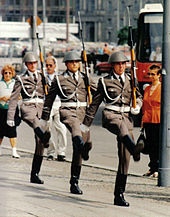Large guard elevator Unter den Linden
The Great Guard Elevator Unter den Linden in Berlin was a military ritual of honor . Soldiers of the Prussian Guard Grenadier Regiment No. 1 carried out this lift for the first time on September 18, 1818 on the occasion of the visit of Tsar Alexander I in front of the Neue Wache , which was built in the same year . The main and royal guard for the Royal Palace opposite was also dedicated to the memory of the Wars of Liberation from the start .
history

The ritual took place for 100 years until the end of the monarchy in November 1918, with the regiments of the guards changing every day. According to a certain key, each formation of the guard corps stationed in Berlin and the surrounding area had its turn at least once a year. The event ended with a concert by the respective regimental band in the chestnut grove.
The Weimar Republic had initially abolished guard troops and the guard elevator until the Reichswehr formed the Berlin guard in 1921 . It was composed of companies from all infantry regiments, each commanded to Berlin for three months. It was not until 1925 that Reich President Paul von Hindenburg reintroduced large guard elevators. Twice a week a company of the guard troop marched with music through the Brandenburg Gate, across Pariser Platz into Unter den Linden, and then turned into Wilhelmstrasse and relieved the guard in front of the Reichspräsidentischespalais . On May 31, the anniversary of the Skagerrak Battle , the Reichsmarine organized the watch lift.
At the Neue Wache, which was redesigned in 1931 as a memorial for the victims of the First World War , there was no military watch. Two police officers guarded the memorial. On March 12, 1933, the National Socialists reintroduced the “Guard Elevator Unter den Linden”, as in the Imperial Era at the Neue Wache with music, organized by the Guard Regiment Greater Germany, which emerged from the Guard (from 1937 “Wachregiment Berlin”) and later also by the Guard battalion of the Luftwaffe under the command of a lieutenant on horseback. Up until the Battle of Berlin in the last weeks of the Second World War , the Great Guard Elevator moved across the linden trees in front of the Neue Wache.
During the GDR era , on May 1, 1962, the National People's Army (NVA) resumed the ritual of the great watch lift at the Neue Wache, which had been transformed into a memorial for the victims of fascism and militarism . An honor guard of two soldiers with parade rifles and attached bayonets stood to the right and left of the entrance to the Neue Wache during the day and was relieved every hour. Every Wednesday as well as on high national holidays at 2.30 p.m., broadcast directly from the Berlin radio station , the Great Guard was held. In addition, an honorary company in parade uniform marched with the staff music corps of the NVA from the Friedrich-Engels-Kaserne on Kupfergraben over the streets Am Kupfergraben - Friedrichstrasse - Unter den Linden to the memorial. There the changing of the guard took place, followed by a parade in a drill step . This military ritual, originally that of old Prussia , developed into an attraction for Berlin tourists in the GDR.
The participants in the Great Guard were part of the Friedrich Engels NVA Guard Regiment , which was stationed in the Friedrich Engels barracks on the left bank of the Spree across from Museum Island . After 28 years, the last Great Watch took place on September 26, 1990, a few days before German reunification . The Federal Republic of Germany did not continue the tradition of the Great Guard Elevator in front of the Neue Wache memorial after reunification. However, the memorial was redesigned again.
literature
- Christoph Stölzl (Ed.): The new guard on Unter den Linden. A German monument in the course of history . Koehler and Amelang, Munich 1993. ISBN 3-7338-0178-4 .
Web links
Individual evidence
- ↑ Klaus-Rainer Week: From waking up to tattooing. The history of the Berlin garrison. Vowinckel, Berg am Starnberger See, Potsdam 1998, ISBN 3-921655-87-0 , pp. 97-99
- ↑ Klaus-Rainer Week: From waking up to tattooing. The history of the Berlin garrison. Vowinckel, Berg am Starnberger See, Potsdam 1998, ISBN 3-921655-87-0 , p. 133 f.
- ↑ Laurenz Demps : The New Guard. From the royal guard house to the central memorial site [individual publication by the Berlin State Archives]. Vbb, Berlin 2011, ISBN 978-3-86650-086-0 , p. 102.
- ↑ Laurenz Demps: The New Guard. From the royal guard house to the central memorial . [Individual publication by the Berlin State Archives]. Vbb, Berlin 2011, ISBN 978-3-86650-086-0 , p. 104.
- ↑ Klaus-Rainer Week: From waking up to tattooing. The history of the Berlin garrison. Vowinckel, Berg am Starnberger See, Potsdam 1998, ISBN 3-921655-87-0 , p. 141 fu 147 f.
- ↑ Laurenz Demps: The New Guard. From the royal guard house to the central memorial site [individual publication by the Berlin State Archives]. Vbb, Berlin 2011, ISBN 978-3-86650-086-0 , p. 133.
- ↑ When the Great Elevator pulled away . In: Berliner Zeitung , September 27, 1990, p. 16.


